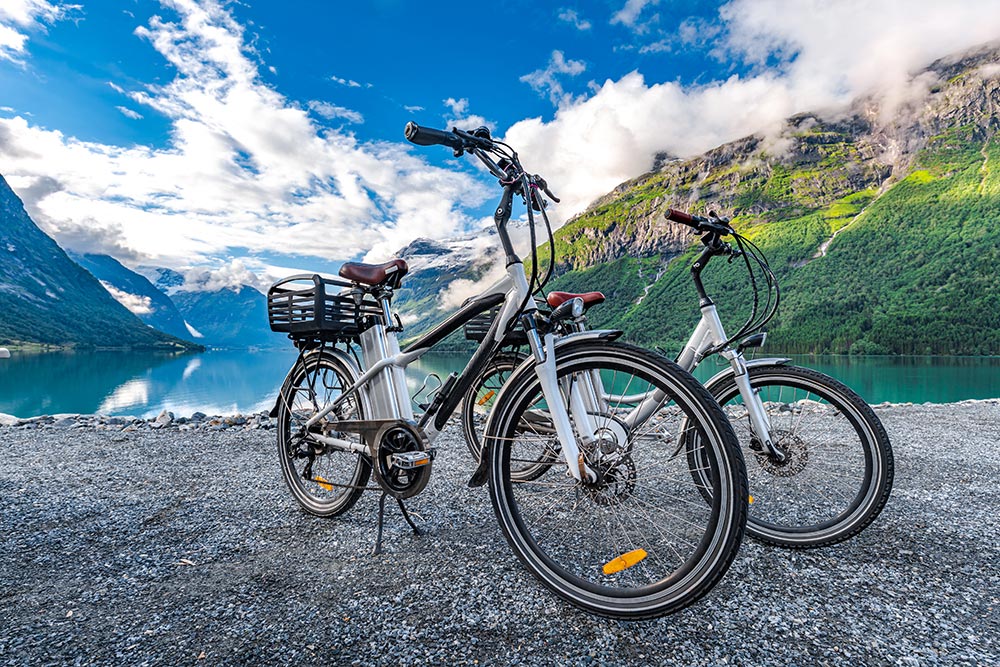
The outdoor life is all very well – if only it wasn’t so exhausting!
Caravan owners have for a long time made the most of their love for a healthy outdoors lifestyle clear by taking a bicycle or two with them on their outings and holidays. Rides in the countryside – or even a quick trip to the farm shop for that extra pint of milk – nicely round out any caravan adventure.
If you are navigating the hills and valleys of the gloriously rolling English countryside, though, pushing those pedals around can get pretty tiring.
That’s where an electrically-powered bicycle – an e-bike – can come to your rescue, providing many of the benefits without quite so much pain.
A wider choice than you might have imagined
You might have thought that it was simply a question of choosing a bike with or without any power-assistance. How wrong you would be. If you are opting for a more comfortable ride, electric bikes these days come in all shapes and sizes, designed for all manner of users, which can be carried by large caravans and small.
So, here are just some of the considerations you might want to keep in mind when choosing your e-bike:
Crank or hub?
- for a machine as simple and straight forward as a bike, it might seem strange to dive straight in with the technical terms – but choosing between a crank or hub drive can be one of those critical first decisions;
- just as the term suggests, a crank drive applies electric power to the crank which turns as you pedal – it’s also called a “mid-drive” – and, as you’ll notice when climbing hills, is an especially efficient motor;
- a hub drive drives the hub, of course – and are smaller and lighter, so, may influence your choice on those features alone;
Pedal assist or throttle?
E-bikes work in two ways:
- pedal assist means the motor kicks in when you pedal, making the ride feel more natural;
- throttle control allows you to move without pedalling;
Mountain bike or roadster?
- just as with bikes that have no electric assistance at all, there is a huge range available when it comes to the type of bike you choose – regular, on-street bicycles to off-road mountain bikes, or hybrids of the two;
- power-assisted or not, a mountain bike works very well indeed when you are negotiating off-road terrain – it can be more than usually hard work to ride one on paved roads;
- only set your heart on a rugged-looking mountain bike, therefore, if most of your cycling is going to be off-road – if not, save yourself unnecessary effort, and cash, by investing in a regular roadster;
Power-to-weight and size
- the amount of power needed for your bicycle depends on how you intend to use it – in challenging off-road conditions, of course, you are likely to need more power;
- but more power is also likely to mean greater weight and size – making your e-bike potentially more difficult to transport within the confines of your caravan, on a roof-rack or strapped to an external rack;
Folding e-bikes
- an answer to the size problem is to buy a folding e-bike;
- as an article on the website We Love Camping explains, a folding electric bike solves the problems of stowing and transporting a bicycle in a way that keeps it securely locked away from the hands of thieves.
Check the battery life and range
The bigger the battery, the further your bike will go on a single charge. Battery capacity is measured in watt-hours (Wh), and the most appropriate one for you depends on how far you plan to ride:
- for short rides (10-20 miles), a 250Wh-400Wh battery should be enough;
- for longer journeys (30 miles or more), a 500Wh battery or higher is a better option;
- removable batteries can be charged separately, which is useful if you store your bike outside;
Choose the right frame and wheels
- lightweight aluminium or carbon fibre frames make the bike easier to handle;
- larger wheels (28”-29”) roll better on roads, while smaller wheels (20”-26”) are good for folding bikes or rough terrain;
Brakes matter for safety
With the extra weight and speed of an e-bike, good brakes are essential:
- hydraulic disc brakes may offer the best stopping power in all weather conditions;
- mechanical disc brakes are a cheaper alternative but require more effort to use;
- rim brakes are common on budget bikes but don’t perform as well in wet weather.
Find a comfortable riding position
Comfort is key, especially for longer rides. Step-through frames make it easier to get on and off the bike while adjustable handlebars and seats help you find the best riding position. Suspension forks absorb bumps, which is useful if you’ll be riding on uneven roads or trails.
Look for useful features
Some extras can make your rides safer and more enjoyable:
- built-in lights and reflectors improve visibility;
- mudguards and racks make commuting more practical;
- GPS tracking and strong locks help prevent theft;
- digital displays let you monitor speed, battery level, and distance;
Test ride and compare models
- try different bikes to see what feels best for you.
- look for reputable brands that offer good warranties and support.
- read customer reviews to check reliability and performance.
Final thoughts
An electric bike gives you all the joys of cycling while on holidays in your caravan – without so much pain in pushing the pedals. As we’ve explained, however, there are a number of points you might want to consider before settling on your choice of e-bike. By considering the motor, battery, frame, and safety features, you’ll hopefully find a bike that makes your journeys easier and more enjoyable.
Further reading: Read about UK e-bike laws here

